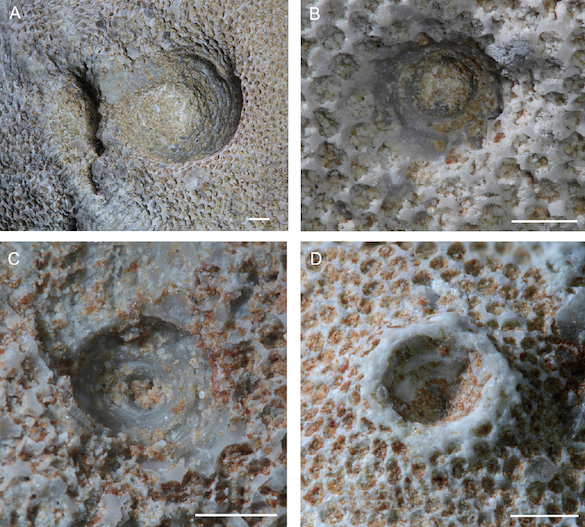 Bioclaustration is the process by which an organism is embedded within the growing skeleton of another. Bioclaustrations are fascinating in the fossil record because they give direct information about how two or more organisms lived together in the ancient past — a form of symbiosis. My Estonian and German colleagues have just published a paper in the journal Geobios on the rapid burst of bioclaustrations in the Late Ordovician. The senior author is the indefatigable Olev Vinn. The abstract tells the story —
Bioclaustration is the process by which an organism is embedded within the growing skeleton of another. Bioclaustrations are fascinating in the fossil record because they give direct information about how two or more organisms lived together in the ancient past — a form of symbiosis. My Estonian and German colleagues have just published a paper in the journal Geobios on the rapid burst of bioclaustrations in the Late Ordovician. The senior author is the indefatigable Olev Vinn. The abstract tells the story —
ABSTRACT: There was a sudden increase in the diversity of bioclaustrations in the Sandbian (Late Ordovician) that continued somewhat more slowly in the Katian. The Sandbian was also the time when bioclaustrations became common, at least in Baltica. The major increase in the diversity of bioclaustrations in the Late Ordovician was an outcome of the GOBE [Great Ordovician Biodiversification Event], and we term it the Ordovician Bioclaustration Revolution. The Ordovician Bioerosion Revolution may partially be responsible for the beginning of the Ordovician Bioclaustration Revolution in the Sandbian, as a number of these early bioclaustrations started their growth from initial borings. The diversification of bioclaustrations in the Sandbian involves mostly bryozoans and, to a lesser extent, brachiopods as hosts. The Katian increase in bioclaustration diversity involves mostly corals as the hosts and was likely unrelated or at least less influenced by the Ordovician Bioerosion Revolution. A new broadly conical bioclaustration, Kuckerichnus kirsimaei nov. cgen., nov. csp., is here described from the growth surfaces of hemispherical trepostome bryozoan colonies of Diplotrypa bicornis, Mesotrypa orientalis and Mesotrypa excentrica from the early Sandbian (Late Ordovician) of Estonia.
The top image is from Figure 2 in the paper. The caption: Holotype GIT 343-45-2 of Kuckerichnus kirsimaei nov. cgen., nov. csp. in Diplotrypa bicornis from the Küttejõu opencast mine, Kukruse Regional Stage. B. Paratype GIT 343-45-4 of Kuckerichnus kirsimaei nov. cgen., nov. csp. in Diplotrypa bicornis from the Küttejõu opencast mine, Kukruse Regional Stage. C. Paratype GIT 343-45-5 of Kuckerichnus kirsimaei nov. cgen., nov. csp. in Diplotrypa bicornis from the Küttejõu opencast mine, Kukruse Regional Stage. D. Paratype GIT 343-48-1 of Kuckerichnus kirsimaei nov. cgen., nov. csp. in Mesotrypa orientalis from the Küttejõu opencast mine, Kukruse Regional Stage. Scale bars: 1 mm.
I enjoyed this project very much because it summarizes decades of work going back to when my friend Tim Palmer and I were working together for the first time in the 1980s. It is nice to see so many concepts and observations coming together into coherent, testable evolutionary hypotheses.
Reference:
Vinn, O., Wilson, M.A., Ernst, A. and Toom, U. 2023. The Ordovician bioclaustration revolution. Geobios (https://doi.org/10.1016/j.geobios.2022.10.007) [Link goes to free pdf until July 25, 2023.]


